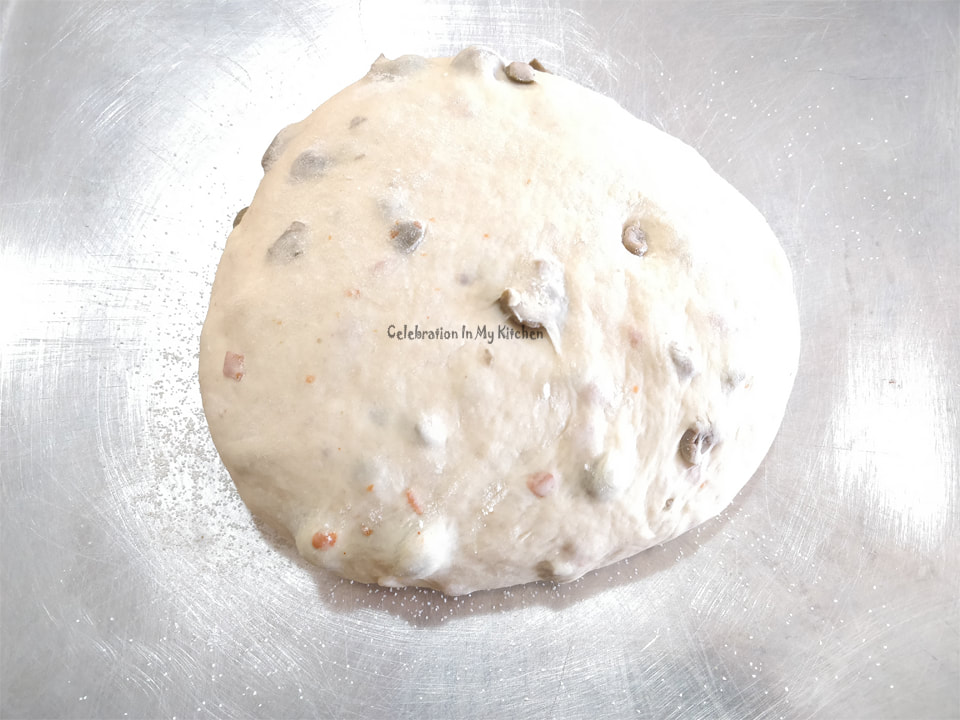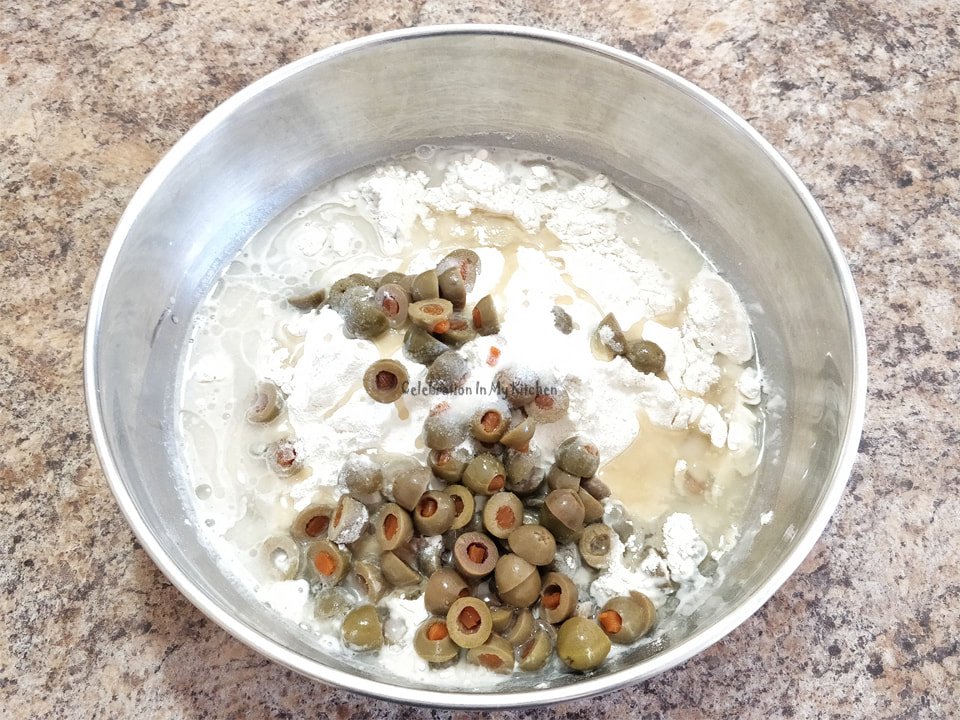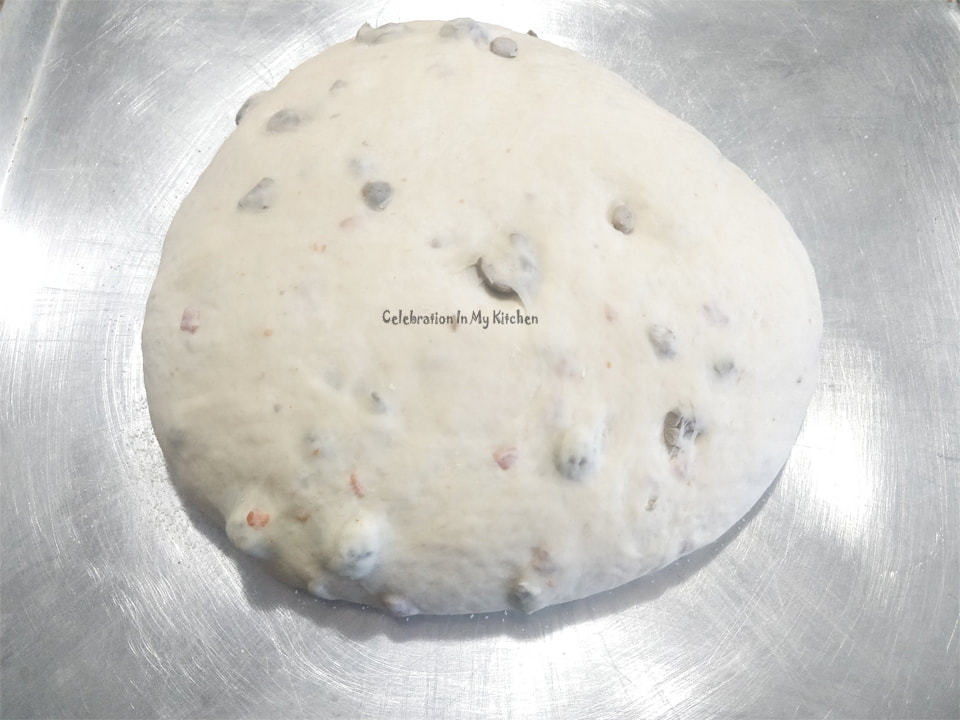A popular bread flavoured with olives and easy to make at home. There are a wide variety of olive breads, usually prepared with brine-cured olives, either black or green. I had the green pitted ones that were stuffed with a piece of carrot on hand. The bread was absolutely delicious on its own with a depth of flavour from the olives. Addition of olive oil enhanced the taste and texture, while contributing to a tender crumb with a delicate, crispier crust. This bread is often paired with feta cheese for a hearty snack. Alternatively, can be enjoyed with olive oil or vinegar. Perfect for a picnic, smeared with a spread or tapenade.
Olives differ in colour, shapes, sizes and taste. Also, depends when they are harvested and the way they are cured. Ripened or mature olives are black, while unripe and young ones are green, picked for their dense flavour. To make olives more palatable, they have to be cured to get rid of the bitterness. Common curing processes use dry salt, brine, water or lye treatments. Green olives contain double the amount of sodium, whereas the black variety has more oil and less salt. There is no nutritional differences between both the olives. They have high amounts of monounsaturated fats and minerals, such as iron and copper. Rich in antioxidants that have anti-inflammatory benefits. Heart healthy and lowers cholesterol. Boosts iron absorption and maintains metabolism. Improves skin, hair, eyes and has anti-aging properties. Protects against ulcers and prevents some cancers. Cured olives are high in sodium, so consuming in moderation is key.
Olives differ in colour, shapes, sizes and taste. Also, depends when they are harvested and the way they are cured. Ripened or mature olives are black, while unripe and young ones are green, picked for their dense flavour. To make olives more palatable, they have to be cured to get rid of the bitterness. Common curing processes use dry salt, brine, water or lye treatments. Green olives contain double the amount of sodium, whereas the black variety has more oil and less salt. There is no nutritional differences between both the olives. They have high amounts of monounsaturated fats and minerals, such as iron and copper. Rich in antioxidants that have anti-inflammatory benefits. Heart healthy and lowers cholesterol. Boosts iron absorption and maintains metabolism. Improves skin, hair, eyes and has anti-aging properties. Protects against ulcers and prevents some cancers. Cured olives are high in sodium, so consuming in moderation is key.
Olive Bread
(Yields 1 Loaf)
Ingredients:
3 cups + 1 tablespoon all-purpose flour
1 cup pitted olives (black or green)
1 1/4 cups lukewarm water
2 1/4 teaspoons active dry yeast
1 teaspoon sugar
1/4 cup olive oil
1/2 teaspoon salt
Method:
Chop olives into pieces, drain well and dry out moisture with a thick kitchen tissue.
Stir the yeast with the lukewarm water and 1 teaspoon sugar. Set aside for a few minutes to foam and froth.
Sift 3 cups of flour with salt in a bowl. Add the yeast mixture, olives, olive oil and salt. Mix to form a dough, which will be soft due to the olives. In case it is sticky to the touch, sprinkle the balance 1 tablespoon of flour.
Note:
Place dough in a greased bowl, turning once. Cover with plastic wrap and let dough rise in a warm place for 1 hour.
Once risen, deflate the air from the dough and transfer onto a work surface sprinkled with some flour. Shape dough into a round loaf. Place on a baking sheet lined with parchment paper and use a tea strainer to dust the top with some flour. Cover with a kitchen towel and set aside to rise in a warm place for 30 minutes.
Note:
Preheat the oven to 450 F or 230 C and heat a dutch oven or deep cake pan for 15 minutes.
Spray the loaf with water just before baking and gently slide it with the parchment paper into the hot dutch oven or cake pan. Cover with a lid and bake for 30 minutes. Remove the cover and bake for an additional 25 to 30 minutes until the crust is golden brown in colour.
Note:
Carefully remove the hot dutch oven or cake pan from the oven. Hold the parchment paper and transfer bread onto a wire rack to cool.
Note:
(Yields 1 Loaf)
Ingredients:
3 cups + 1 tablespoon all-purpose flour
1 cup pitted olives (black or green)
1 1/4 cups lukewarm water
2 1/4 teaspoons active dry yeast
1 teaspoon sugar
1/4 cup olive oil
1/2 teaspoon salt
Method:
Chop olives into pieces, drain well and dry out moisture with a thick kitchen tissue.
Stir the yeast with the lukewarm water and 1 teaspoon sugar. Set aside for a few minutes to foam and froth.
Sift 3 cups of flour with salt in a bowl. Add the yeast mixture, olives, olive oil and salt. Mix to form a dough, which will be soft due to the olives. In case it is sticky to the touch, sprinkle the balance 1 tablespoon of flour.
Note:
- Important to dry out the olives well after they are chopped.
- Knead gently into a dough.
- It is always good to have a slightly soft dough for a tender crumb bread.
Place dough in a greased bowl, turning once. Cover with plastic wrap and let dough rise in a warm place for 1 hour.
Once risen, deflate the air from the dough and transfer onto a work surface sprinkled with some flour. Shape dough into a round loaf. Place on a baking sheet lined with parchment paper and use a tea strainer to dust the top with some flour. Cover with a kitchen towel and set aside to rise in a warm place for 30 minutes.
Note:
- Ensure to dust the dough with flour before the second rising or else, the kitchen towel will stick to it.
Preheat the oven to 450 F or 230 C and heat a dutch oven or deep cake pan for 15 minutes.
Spray the loaf with water just before baking and gently slide it with the parchment paper into the hot dutch oven or cake pan. Cover with a lid and bake for 30 minutes. Remove the cover and bake for an additional 25 to 30 minutes until the crust is golden brown in colour.
Note:
- Placing the dough on the parchment paper makes it easy to slide both into the hot pan without deflating it.
Carefully remove the hot dutch oven or cake pan from the oven. Hold the parchment paper and transfer bread onto a wire rack to cool.
Note:
- An oven safe deep, wide and thick-bottomed stainless steel pot can be used.
- Olive bread was made with green olives that were stuffed with a piece of carrot.
- After cooling the loaf, if the crust of the olive bread has lost its crispiness, heat the loaf in a preheated 400 F or 200 C oven for 8 minutes. Alternatively, the loaf can be sliced and heated in the oven for a few minutes or to required doneness.
- To make the below plain crusty loaf without olives, use 3 cups all-purpose flour and 1 teaspoon salt. Due to the high amount of sodium in the olives, only 1/2 teaspoon of salt was used for the olive bread. Both the loaves were absolutely perfect and delicious.
- Olive bread was baked in a cake pan, whereas the plain crusty loaf in a stainless steel pot.
- Wilton Mega Cooling Rack at: https://amzn.to/3dm0U3L
























